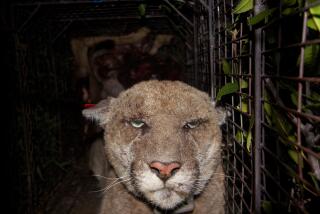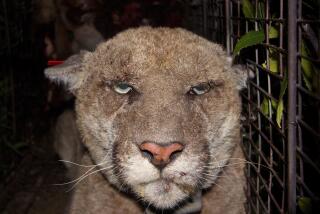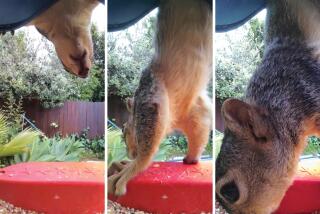Plan to Rout Rampant Rabbits Raises Fears
- Share via
Question: We live in a 36-acre townhouse project nestled on a hillside and we are inundated with rabbits.
Since I am against killing the animals, I’m very concerned that our board has chosen to use poison.
I called the animal control operator, and he said the poison will not kill dogs or cats--yet some rabbits are as big as cats. How can he be right? And what about the food chain? Won’t birds and wild animals eating carcasses get poisoned?
--J.M., Chatsworth
Answer: Rabbit populations, both cottontail and jack rabbit, fluctuate in response to the quality of the habitat. Your townhouse complex, which is probably lushly landscaped with lots of tasty plants and grass and plenty of low-growing shrubs to escape into and nest under, must be rabbit heaven. It may even offer a degree of protection from air and ground assaults, otherwise known as hawks and coyotes.
Although it is common for animal control operators to use poison in large-scale situations where rabbits are ravaging crops, such as farms and orchards, there are better alternatives in smaller, more localized settings like backyards and townhouse complexes. In fact, I prefer almost any other humane technique over poison.
The truth is, poisoning rabbits may be less labor-intensive than fencing the area or trapping, and is certainly more profitable for the animal control operator. But it’s obviously not a public relations coup or you wouldn’t be writing.
It also won’t work for long. Once the rabbits are gone, it may only be a few months before rabbits from outside the complex repopulate the area.
The reason the animal control guy says pets and other nontarget animals won’t be harmed is because of the type of poison he’ll use, probably either Diphacinone or Chlorophacinone.
Both are anticoagulants commonly used as a grain bait, and are either scattered where the rabbits eat or placed in bait stations. The poisoned animal ends up bleeding to death.
According to a representative at the state Environmental Protection Agency, anticoagulants have a long safety record. In fact, for the bait to work, the animal has to feed almost exclusively on it for a week. Should an animal eat the bait once or twice, it will probably get sick but not die.
Since most cats aren’t big on eating grains like oats and barley, chances are you won’t have to worry about them. But dogs are less particular and may ingest at least some if it’s left where they have access.
If your dog is anything like mine, she’d eat poison until the cows come home, vomit and then go back for more.
A greater concern for those of us with little kids, particularly toddlers, is their uncanny desire to cram everything that comes into their line of vision in their mouths.
So while the experts blather on, assuring us that this nasty stuff is safe, I’d err on the side of caution and keep my pets in and watch my kids closely.
The good news is that the bait is dyed a green or blue color so that it won’t be attractive to birds, which might be poisoned if they ate it.
As far as the food chain goes, there are few secondary hazards because of the bait’s nonacute status. That’s to say, like the bait, many poisoned carcasses would have to be eaten before the diner would be poisoned.
And if the animal control company is doing its job, it should be picking up carcasses a couple of times a day once the rabbits begin to die.
In any event, more information is always better, so find out when the control program is going to take place, where the bait is being placed, and what precautions the animal control company is going to take to protect your children and your dog.
If your complex has cottontails, not jack rabbits (you neglected to mention which), insist that the poison be placed inside a child-proof bait station rather than out in the open because jacks are reluctant to enter into enclosed bait stations.
When the control program is over, the company should remove all bait that hasn’t been consumed.
Homeowners can keep cottontails out of gardens and yards by eliminating escape cover like juniper as well as stacks of wood and piles of brush, or by constructing a simple, inexpensive fence made from chicken wire or hardware cloth. You can find these at almost any hardware store.
Because jack rabbits rely on speed and agility to dodge predators rather than escape cover, you’ll have to fence them out if you do not want to poison them. Make sure the fence is 3 feet high, and bury it into the ground six inches or so. Stake it every six feet or as often as needed. Be sure gates have sills on them so the rabbits won’t slip underneath.
* Got critter conflicts? Send your queries to wildlife biologist Andrea Kitay at P.O. Box 2489, Camarillo, CA 93011, or via e-mail to [email protected]. Please include your name and city. Questions cannot be answered individually.
* For a list of wildlife bulletins that provide sound advice on homeowner-wildlife conflicts ($4 each), send a stamped, self-addressed envelope to the above address, or visit https://www.livingwithwildlife.com.
More to Read
Sign up for Essential California
The most important California stories and recommendations in your inbox every morning.
You may occasionally receive promotional content from the Los Angeles Times.









